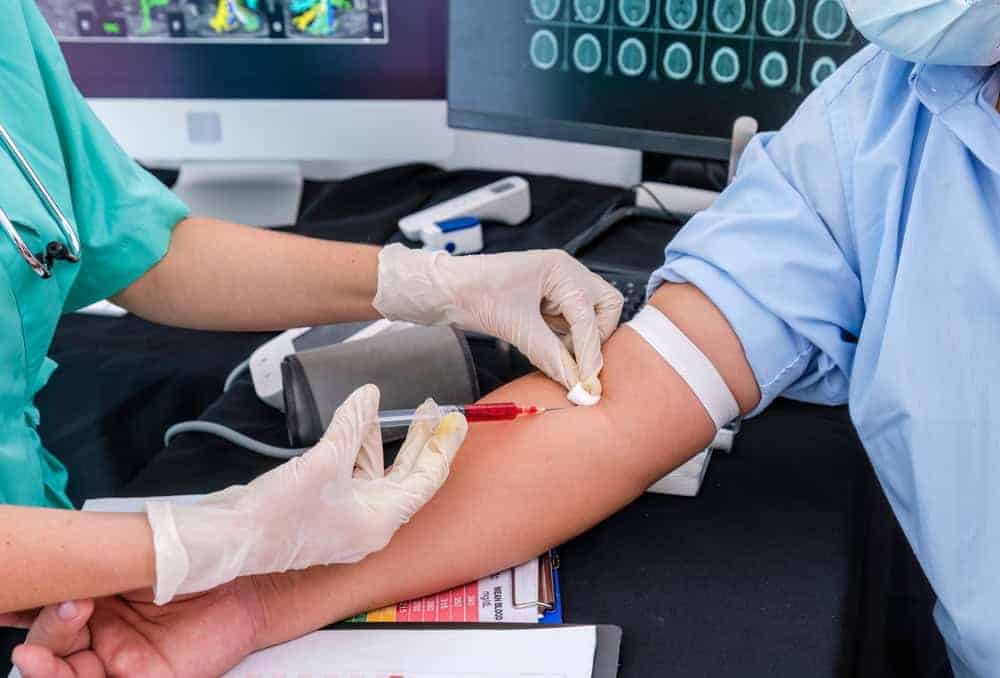
Prothrombin time or PT is a key part of managing your health, especially as you age. Why? For one, PT tests can help your doctors see how well your blood is clotting. It’s important because blood clots help stop bleeding when you get injured. Blood that forms clots too easily or too slowly can be a sign of serious problems like strokes, heart attacks, or severe bleeding.
In this article, explore what PT is, why it matters, and how the test is done. By the end, you’ll understand PT and its role in keeping you healthy.
What Is PT?
PT stands for prothrombin time. Prothrombin is a form of protein your liver produces that helps in the blood clotting process. Essentially, PT is a blood test that measures how long it takes for a clot to form after a wound.
Blood clotting is essential because it stops bleeding when you get injured. Without proper clotting, even a small cut can cause bleeding. Blood that clots too easily is associated with serious health problems like strokes or heart attacks.
PT helps doctors check the function of proteins in your blood that help with clotting. These proteins are called coagulation factors. If these factors don’t work right, you can have bleeding problems or form dangerous clots.
Think of coagulation factors as the ingredients in a recipe. If any of these ingredients aren’t of the right measures, the recipe won’t turn out right. The PT test checks to make sure all the factors that help your blood clot are normal.
Who Is This Test For?
According to the National Blood Clot Alliance, more than eight million Americans take blood thinners. These drugs are often prescribed to prevent blood clots from forming in people with the following conditions:
- Heart or blood vessel conditions
- Abnormal heart rhythm
- Congenital heart defects
- Those with a risk of blood clots after surgery
- People who’ve had a heart valve replacement
When blood clots form, the risk of stroke, heart attacks, and blockages is high. So, if your loved one has any of these conditions, they need regular blood tests to ensure their medications are working correctly. One of the most important tests is called the prothrombin time or PT test. Understanding PT is crucial for anyone who’s looking to maintain good health, especially if you have conditions that affect your blood’s ability to clot.
Moreover, the PT test is crucial for detecting and diagnosing certain health conditions. For instance, abnormal PT levels can indicate liver disease.
What Does PT Measure?
A PT measures the time it takes for your blood to form a clot. When you get a PT test, a sample of your blood is mixed with a substance called thromboplastin and calcium, substances that start the clotting process. Then, doctors assess how long the blood hardens and coagulates (usually in seconds).
This measurement is critical for diagnosing bleeding disorders like hemophilia or conditions that cause too much clotting, such as deep vein thrombosis (DVT). For people on blood-thinning medications like warfarin, PT ensures the medication is working as it’s intended to prevent dangerous clots.
Here’s an example, — imagine accidentally cutting your finger while chopping vegetables. Your body starts the clotting process to stop the bleeding. If this process is too slow, you might lose a lot of blood from even a minor cut. If your blood clots too quickly, you could develop clots in your blood vessels that can travel to your heart or brain, leading to life-threatening conditions.
PT is a critical tool for doctors because it helps them diagnose and manage potential health issues before they become serious. With a PT test, they can see how well your clotting factors work. From this information, they can diagnose conditions like hemophilia, liver disease, and vitamin K deficiencies.
How is the PT Test Conducted?

If your loved one needs a PT test, know that getting one is simple and quick. Do you want to know how you can prepare for it? Below is an overview of the step-by-step process of how it’s usually done.
Preparation
-
- Before the test, you might be asked to avoid certain medications or foods that can affect your results. Always follow your doctor’s instructions.
- Foods rich in vitamin K, like leafy greens, can affect PT results. Some medications, including over-the-counter drugs like aspirin, can also influence PT levels.
- It’s essential to comply with your doctor’s instructions on preparing for the test. You or your loved one may be asked to fast from eating foods for a certain period, avoid certain foods, or temporarily stop certain prescriptions.
- Make sure to inform your doctor of all medications you’re taking, including over-the-counter drugs, supplements, and herbal remedies.
- Wear a short-sleeved shirt or a shirt with sleeves that can be easily rolled up so your doctor can draw blood more easily.
Blood Sample Collection
-
- Your doctor will draw a small sample of your blood, usually from a vein in your arm.
- The process is similar to any other blood test. The area where the needle will be inserted is cleaned with an antiseptic, and a tourniquet is applied to your upper arm to fill your veins with blood.
- The needle is then inserted, and blood is collected in a vial. For most people, this process is quick and relatively painless though you may feel a slight pinch when the needle goes in.
Laboratory Analysis
-
- Afterward, the blood sample is sent to a lab where it is mixed with thromboplastin and calcium to start the clotting process. These substances are added to mimic the conditions in your body that would trigger clotting.
- The lab technician measures the time it takes for your blood to clot, which is your PT result. It’s usually done using specialized equipment that can precisely measure the clotting time in seconds.
That’s it! The PT test is fairly straightforward unless you or your loved one has a fear of needles.
5 Common Reasons for Conducting a PT Test

Doctors will recommend a PT test for the following significant reasons:
1. Monitor Blood-Thinning Medication
If you are taking anticoagulants like warfarin, regular PT tests help ensure the medication is effective at threatening blood clots. In addition, the result will also show you’re taking the correct drug dosage and following the instructions to take them. It can be life-threatening if they don’t work as intended.
2. Diagnose Bleeding Disorders
PT test results can help doctors spot and diagnose conditions like hemophilia or von Willebrand disease.
3. Check Liver Function
The liver produces many types of protein that help with the clotting process. A PT test can help doctors evaluate the state of your liver.
4. As Part of a Pre-surgery Test
Your doctor may also suggest a PT test before certain surgery or medical procedures to check and ensure whether your blood will clot properly during and after the abscission.
5. Investigate Unexplained Bleeding
If you have symptoms of unusual or excessive bleeding, a PT test can help determine the underlying cause of such abnormality.
While the test itself is quick, getting the results can take a bit longer, depending on the lab’s workload and procedures. You may get your results within a few hours or up to several days. Your healthcare provider will meet with you to discuss the outcome and what it means for your health.
Interpreting PT Results

The normal range for PT typically falls between 11 and 13.5 seconds and INR of 0.8 to 1.1 if you’re not taking any blood thinning agents, like warfarin. INR or International Normalized Ratio is a standard measurement of a clotting tendency. If you’re taking warfarin, your INR should hover from 2.0 to 3.0.
An INR that’s too high means one is at an increased risk of bleeding. If it’s too low, one is at an increased risk of blood clotting. Depending on the result, the doctor will adjust the medication dose to achieve the target INR range.
An abnormal PT result can indicate several issues:
- Prolonged PT: It means your blood is taking longer than normal to clot. It can suggest conditions like liver disease, vitamin K deficiency, or the presence of certain anticoagulants. A prolonged PT can also indicate a deficiency in one or more of the clotting factors. The reasons can be due to an inherited condition, such as hemophilia, or an acquired condition, such as liver disease or vitamin K deficiency.
- Shortened PT: It’s less common but can occur in situations like disseminated intravascular coagulation (DIC), where blood clots form throughout the body. It’s a serious condition and requires immediate medical attention.
While you can technically interpret your PT results, it isn’t something you should do on your own. Always consult your healthcare provider. They’ll take into account your medical history, current medications, and other lab results to determine the overall significance of your PT result.
In some cases, your healthcare provider may order additional tests to get a clearer picture of your blood clotting function. For example, they may order a partial thromboplastin time (PTT) test, which measures a different factor of blood clotting. Together, these tests can provide a more comprehensive view of your body’s clotting ability and help guide treatment decisions.
Importance of PT in Health Monitoring
PT tests are crucial for people on anticoagulant or blood thinning therapy. For instance, if you or a loved one is taking warfarin to stop blood clots, your PT needs to be within a specific range to guarantee the medication is effective. This range is often expressed in the International Normalized Ratio (INR), which standardizes PT results regardless of the testing method used.
Maintaining appropriate INR levels through a PT test is crucial. It helps manage various risks effectively, like liver disease or vitamin K deficiency. With consistent monitoring, your doctor can detect changes early and adjust your treatment plan as needed.
Differences Between PT and PTT Tests

You might have heard of the partial thromboplastin time (PTT) test and wondered how it differs from PT. While both tests measure blood clotting, they focus on different aspects:
- PT: Measures the extrinsic pathway of coagulation, primarily involving factors VII, V, and X, prothrombin, and fibrinogen.
- PTT: Measures the intrinsic pathway and involves factors XII, XI, VIII, and IX.
PT is used to monitor warfarin therapy. On the other hand, PTT is used to assess heparin therapy. Your healthcare provider will choose the appropriate test based on your condition and treatment plan.
Think of the clotting process as a series of steps leading to the formation of a clot. The PT test looks at the steps that happen outside the blood vessels or the extrinsic pathway, while the PTT test looks at the steps that happen inside the blood vessels or the intrinsic pathway. Both pathways eventually lead to the same end result — a blood clot — but they involve different proteins and mechanisms.
Learning the difference between PT and PTT can help you better understand your health and the tests your doctor might order. These tests are often used together to get a complete picture of your clotting ability.
For example, if you have a prolonged PT and a normal PTT, it may suggest a problem with the extrinsic pathway. But, if you have a prolonged PTT and a normal PT, it may indicate a problem with the intrinsic pathway. By looking at both tests, your doctor can pinpoint where the problem lies and develop an appropriate treatment plan.
Home Testing for PT
Home testing has become more accessible in today’s highly digital age. Now, there are numerous portable devices, allowing you to monitor your PT and INR levels without showing up at your doctor’s clinic. It’s an advantage for individuals on long-term anticoagulant therapy who need regular testing.
Benefits of Home PT Testing
Here are some reasons why you should consider home testing for PT:
Convenience
No need for frequent clinic visits. You can test your PT and INR levels at home and send the results to your healthcare provider electronically.
Timely Adjustments
Immediate results allow for quicker adjustments to medication. It can help prevent complications and ensure you’re always within the therapeutic range.
Improved Compliance
Easier monitoring encourages consistent testing. When testing is more convenient, you or your loved one is more likely to stick with it.
Reduced Stress
For many people, going to a clinic for regular tests can be stressful and time-consuming. Home testing reduces the need for frequent trips, making the process less burdensome.
If you or your loved one takes warfarin, you can use a home PT testing device to check your levels and send the results to your doctor. Your doctor can then adjust your medication without you needing to leave your home. This form of convenience is an advantage for older people.
For someone with mobility issues or living in a rural area far from medical facilities, home PT testing can significantly improve their quality of life by reducing the need for travel.
Considerations for Home PT Testing

Another advantage of using INR test meters at home is they only need a finger stick instead of an entire blood sample. A lancet will prick the finger to obtain a small amount of blood needed for the test. Before you start home testing, you must keep a few things in mind to make sure you get accurate and reliable results.
Accuracy
While home testing devices are generally reliable, just remember they might not be as accurate as laboratory tests. Continue to do regular check-ins with your healthcare provider from time to time to ensure your home results match the lab outcomes and the device is working correctly.
Training
Get trained on how to use your home testing device. This crash course often includes understanding how to collect a blood sample, how to operate, and how to interpret the results.
Communication
Keep your doctor in the loop on your home testing results. They can help interpret the results and make any necessary adjustments to your treatment plan.
Maintenance
Ensure your PT device is well-maintained and calibrated according to the manufacturer’s instructions. Regular maintenance checks can prevent inaccuracies in the outcomes.
Guidelines for Accurate At-Home PT Testing
Regardless if it’s you or your loved one who requires a PT test, follow these guidelines to increase the chance of precise readings.
- Follow Instructions: The INR test meter device will come with a manual. Read it and carefully follow the instructions.
- Consistent Timing: To maintain consistency in your results, try to test at the same time each day, week, or as recommended by your doctor.
- Proper Storage: Store your testing supplies as directed in the manufacturer’s manual to avoid them from becoming faulty.
- Report Issues: If you notice any issues with the device or results, report them to your primary doctor immediately.
Home PT testing can be a valuable tool for managing your health. However, use it correctly and in conjunction with regular medical care. Your doctor can guide whether home testing is right for you and how to integrate it into your overall treatment plan.
Frequently Asked Questions About PT

Below are some commonly asked questions and answers to help you better understand PT testing and what it means for your health.
Why do I need a PT test?
You may need a PT test if you have symptoms of a bleeding disorder, if you’re on blood-thinning medications, or if your doctor needs to assess your liver function. PT tests are also commonly used before surgery or other medical procedures to ensure your blood will clot properly.
What factors can affect my PT results?
Medications, dietary changes — especially those rich in vitamin K — and certain medical conditions can influence your PT results. Always inform your doctor about any changes in your health or medication regimen. For example, foods like spinach, kale, and other leafy greens are high in vitamin K and can affect PT levels. Similarly, certain medications, including over-the-counter drugs like aspirin and ibuprofen, have the same impact.
How often should I have my PT levels checked?
The frequency of PT testing depends on your condition and treatment plan. People on warfarin may need weekly testing, while others might only need occasional monitoring. Your healthcare provider will determine the appropriate testing schedule based on your unique health situation.
Can I improve my PT results naturally?
Maintaining a balanced diet, avoiding excessive alcohol, and following your doctor’s advice on medication can help manage your PT levels. However, never make significant changes without consulting your doctor. For example, if you’re taking blood-thinning medication, your doctor may recommend specific dietary guidelines to ensure your PT levels remain within the therapeutic range.
What is the difference between PT and INR?
PT measures the time it takes for your blood to clot, while INR standardizes PT results to account for differences in testing methods. INR is often used to monitor people on blood-thinning medications like warfarin. If your loved one takes warfarin as a maintenance medication, determining their INR levels is critical in symptom and treatment management.
What should I do if my PT results are outside the normal range?
Contact your healthcare provider immediately. They will guide you on the necessary steps, which may include adjusting your medication or doing another test. Your doctor will consider your overall health, current medications, and other factors to determine the best course of action. In some cases, you may need supplementary tests to identify the underlying cause of the abnormal PT result.
What if I have a bleeding disorder?
If you or a loved one has a bleeding disorder, your PT levels will likely be abnormal. Your doctor will use your PT results, along with other tests, to diagnose and manage your condition.
How does liver disease affect PT levels?
People with liver disease often have unhealthy PT levels because the liver produces many of the clotting factors. Monitoring PT can help assess liver function and guide treatment decisions.
How can PT help monitor my medication?
If you’re on blood-thinning medication, regular PT testing is important to check whether the medication is working correctly and to adjust the dosage if needed.
Can I eat leafy greens while on blood thinners?
Yes, but it’s ideal to maintain a consistent intake of vitamin K-rich foods like leafy greens. Sudden changes in your diet can affect your PT and INR levels. Consult your healthcare provider for specific dietary guidelines.
A PT Test Is Critical to Monitor General Health

Your health is your wealth. Understanding the role of prothrombin time is a key part of maintaining it. PT testing might seem like a small aspect, but it plays a vital role in diagnosing and managing conditions related to blood clotting. Whether you’re managing a chronic condition, taking blood-thinning medication, or preparing for a medical procedure, knowing your PT levels can make a world of difference in your well-being.
Regular PT testing is one of the tools that help you stay informed and proactive about your health. By keeping track of the PT levels, you can prevent potential complications and maintain a healthier life.
Enlist a Caregiver to Help With At-Home PT Test
Taking charge of your health can sometimes feel overwhelming, especially with all the medical jargon you or your loved one has to learn. If you ever feel uncertain about your PT levels or what your test results mean, Amy’s Eden Senior Care has trained caregivers to guide you on how to correctly use INR test meters at home. We are here to support your family and provide you with the best resources for navigating the complexities of PT and blood clotting.
PT is more than just a number. It’s an important part of your health. Our dependable caregivers are here to help you take charge of your well-being and life by encouraging you to be proactive in caring for your health. Get in touch with us and find a friendly caregiver who’ll be with you every step of the way.




